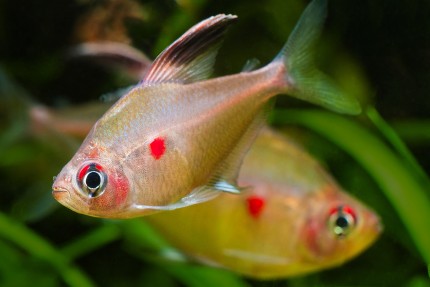incl. VAT plus shipping costs
Currently not available
Delivery only innh. Germany and Austria possible.
Switch to the German store
- Item no: 10654
Fast delivery times
All products are in stock with us!14 years of breeding experience
Let our team of experts advise you!High customer satisfaction
from over 3,000 reviews "| Water values: | soft to medium hard |
| Visual effect: | Especially colorful |
| Temperature: | 25-30 °C |
| Behavior: | Active |
| Feature: | Interesting coloring |
| with fish?: | Yes, with peaceful fish |
| Breeding: | medium |
| Difficulty: | 2 - Normal |
| Diet: | omnivorous - omnivorous |
| Planting possible?: | Yes |
| Origin: | South America |
| with snails/shells?: | Yes |
| with dwarf crabs?: | Yes |
| with shrimps?: | with dwarf shrimps, offspring is eaten |
| Final size: | 4-8 cm |
| Fish group: | Tetra |
| with large crabs?: | No |
| Pelvic region: | Center |
| Aquarium size: | 200 l (approx. 100cm) |
| with crabs?: | No |
The Brazilian Cherry Spotted Tetra, also known as Socolfs Cherry Spotted Tetra, is one of the true t etras. Scientifically Hyphessobrycon scolofi named it is occasionally confused with Hyphessobrycon erythrostigma. Originally these pretty tetras come from South America, where they are mainly found in the Rio Negro, as well as its tributaries, but also in smaller streams. With their namesake red splash of color, they are a great addition to the aquarium, immediately catching the eye and are also suitable for beginners.
The animals are high-backed with strongly compressed sides. In general the body seems rather gray-brown to olive and yellowish. The reddish lateral line is pronounced and runs straight, starting behind the eye and ending in a red spot on the root of the tail. On the shoulders the animals have a red spot, which gave them their German name.... The eye is also rimmed with red. Depending on the mood, the cherry spotted tetras color more intensely. Striking is the long extended dorsal fin, which is colored both black and red, the first fin rays are white - males form these longer. Typical for tetras, Hyphessobrycon socolfi has a sail-shaped, elongated anal fin and an adipose fin. The females differ visually from the males by a pronounced high back and slightly less intense colors, they also appear more bulky. Cherry spotted tetras grow to about 5-6 cm in length.
The breeding of Brazilian Cherry Spot Tetras is difficult in the aquarium. According to the literature a shallow spawning aquarium from approx. 80 cm edge length with very soft water under a total hardness of 4 degrees and a pH value around 7.0-7.5 is recommended. Java moss is added to the aquarium as spawning substrate and the breeding pair is brought into the mood with several daily live feedings. They should be moved quickly after spawning, as they are strong spawn predators. After about 24-48 hours the first young hatch, which swim free after about a week. They can be fed with very fine live food such as nauplii, infusoria or paramecia afterwards.
Cherry spotted tetras are shy, but also very social creatures that derive their strength from group size. Therefore it is best to keep them in a shoal of not less than 10 animals, otherwise they will very quickly become careless and shy, so that they will only stay hidden and will not really show their colors anymore. Since they are also quite territorial, you should structure the aquarium accordingly. Male cherry spotted tetras impress each other when they meet, but no serious fights occur. So that the great tetras can behave according to their species, an aquarium size from 150 liters, rather larger is recommended. Design the substrate rather dark and create territorial boundaries and privacy screens with bog pine roots. Plant the background and the sides with weedy aquatic plants, also the water surface should be somewhat darkened with floating plants to promote the well-being of the fish. In order for the animals to be able to swim out, they should be given enough free swimming space. At water values with a total hardness between 5-15 °dGH and a pH-value of 5,5-7,5 they can be maintained well.
Brazilian Cherry Spotted Tetras may become a bit more rowdy with age, but can otherwise be socialized with other peaceful fish that come from similar water parameters. Since they feed on larger live foods such as mosquitoes and worms, among other things, socialization with dwarf shrimp is not recommended.
As omnivores, the Brazilian Cherry Spotted Tetra can be fed well in the aquarium with commercial dry food, but also with tabs. It also accepts flakes or granules without problems. As it knows it from its habitat, however, it should get frozen or live food in the form of white or black mosquito larvae just as regularly, also Daphnia or Artemia it will eat with preference.
Our food recommendation: The NatureHolic Main Feed is a professional staple food for all aquarium fish. Main feed we supply in the form of soft granules, which thanks to its grain size of half a millimeter can be easily absorbed by small to medium-sized fish. The soft consistency resembles the texture of insect larvae in nature and protects the fish mouth from micro-injuries.
Our plant recommendation: Use for planting NatureHolic InVitros. These are free of snails, planarians and other unwanted co-inhabitants. Also free from algae spores, bacteria and fungi.
Expert Tip: We recommend for fish keeping the NatureHolic 3 Phase Liquid. The care set offers the best all-round protection for your animals. It ensures optimal conditions for successful breeding and keeping.
| Scientific name: | Hyphessobrycon socolfi |
| German Name: | Brazilian cherry spotted tetra |
| Difficulty level: | for beginners |
| Origin/Distribution: | South America |
| Coloration: | High-backed body with flat sides, ground color greenish brown, back darker. Conspicuous red spot, strongly elongated dorsal fin and extended anal fin, adipose fin. Females plumper to 6 cm, males more colorful and slender. |
| Age expectancy | unknown |
| Water parameters: | GH 5-15 °dH, pH 6.5-7.5, temperature 24-28 °C |
| Tank size: | from 150 l |
| Food | Natureholic main feed, live and frozen food such as Artemia, Cyclops, Daphnia |
| Breeding | difficult |
| Behavior | peaceful, territorial in places at spawning time |
| Group size | 10 and up |
| Further information | Ten typical aquarium fish for beginners and alternatives to them, Tips for acclimating fish to the aquarium, Feeding aquarium fish properly - cheap food and what it can do |
- Item no: 10654
Entdecke die Garnelio Welt!
Garnelio gehört zu den größten Onlineshops für wirbellose Aquarientiere weltweit.
Viele Artikel gibt es exklusiv nur bei uns im Shop.




















